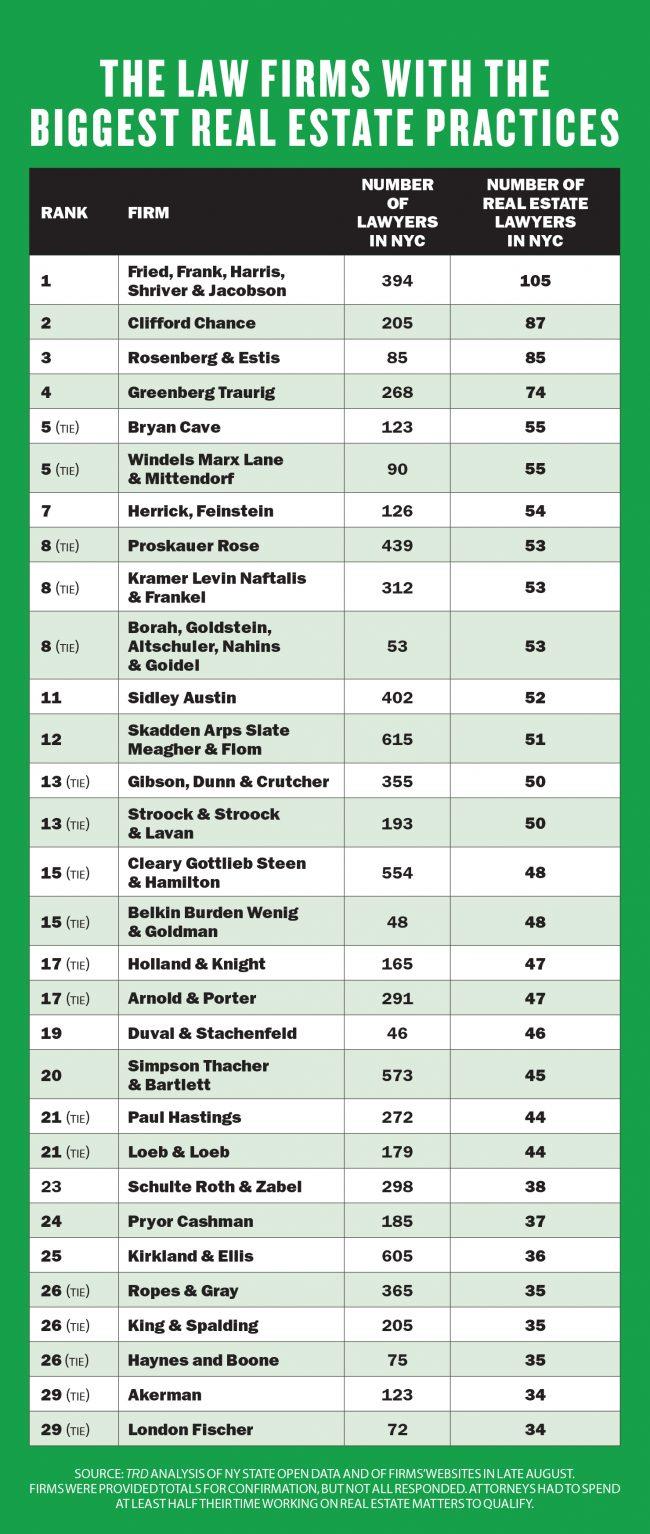Trending
NYC’s barrister brain trust
Law firms are getting ‘inundated’ with calls in the wake of Albany’s rent reforms as they also juggle complex office leases, mega-loans and distressed funds in today’s uncertain market

The calls began almost as soon as the new rent laws passed.
Overnight, the sweeping regulations — which Gov. Andrew Cuomo signed in June — vastly restricted what landlords could do with rent-regulated apartments.
And those landlords, crushed from a stinging political defeat and given no grace period to adjust to the new rules, turned immediately to their lawyers.
Luise Barrack, managing member of the law firm Rosenberg & Estis, said her firm started fielding “millions of calls” from clients right after the law was enacted.
“All of a sudden, owners of property who felt entirely confident and knew what the rules of the practice were did not,” she said. “Lawyers and all practitioners dealing with the laws had to get up to speed really quickly on the changes and make sure that our clients were in compliance.”
Not surprisingly, that has translated into a lot of legal work.
“They’ve been dominating the conversation,” Barrack said of the new laws. “Everything has really changed as a result.”
Amid the chaos of the new rent-regulation reality, The Real Deal ranked the city’s top law firms, which are also dealing with everything from loan modifications to distressed funds to trophy building sales to negotiating complicated office leases.
The white-shoe law firm Fried Frank once again landed the top spot on TRD’s headcount ranking, with 105 real estate lawyers in New York — up from 94 last year.
It was followed by Clifford Chance — a regular at the top of the ranking — with 87 real estate lawyers (up from 79 last year) and the real estate-only firm Rosenberg & Estis, with 85 attorneys, according to TRD’s research. The global firm Greenberg Traurig, along with Bryan Cave and Windels Marx Lane & Mittendorf, rounded out the top five spots (the last two tied).
Overall, TRD found 1,523 real estate attorneys working at the top 30 firms as of early September. That was up 2.5 percent from last year.
Attorneys said business has been strong overall.

And while investment sales are down citywide — volume dropped 13.4 percent year over year to $27.3 billion during the first eight months of 2019 — lawyers are being tapped to interpret the new laws. The elimination of vacancy decontrol, new caps on security deposits and new limits on how landlords can raise rents under the Major Capital Improvements and Individual Apartment Improvements programs have all increased the need for legal advice.
“Anything out of the ordinary causes work for lawyers,” said Jay Neveloff, a partner at the law firm Kramer Levin Naftalis & Frankel. “So we’re seeing that.”
The cash stash
Headcounts are nice, but sales and loans are where the money is at.
That’s why TRD pored over property records to stack up law firms by the dollar volume of loans and sales (of $1 million-plus) that they handled during the year-long stretch from July 1, 2018, to June 30, 2019.
Overall, TRD found that the top 30 real estate firms handled $24.8 billion worth of buyer-side sales during the year-long stretch and $69.48 billion worth of lender-side loans.
New York’s largest sale during that period — a $2.2 billion commercial condo at 30 Hudson Yards — was crawling with lawyers.
Mostly notably, Gibson, Dunn & Crutcher represented Related Companies on that deal, which went into contract in April. The developer bought the 1.5 million-square-foot condo from WarnerMedia (it had previously sold it to the media giant) and leased it back to the company. Then in June, Related sold a 49 percent stake in the condo to the German insurance company Allianz.
In total, Fried Frank represented a higher dollar volume of buyer-side deals than any other law firm in the city — with about $3.17 billion in transactions for the stretch TRD reviewed. (There’s of course no way to publicly track how much the firm actually made from that deal.)
Gibson Dunn landed the No. 2 spot, handling about $3.12 billion in New York building sales, followed by Greenberg Traurig with about $2.5 billion, Roberts & Holland with $1.37 billion and Loeb & Loeb with $1.23 billion.
And in a real estate hat trick, Fried Frank also snagged the No. 1 spot on TRD’s loan ranking, handling $7.89 billion in lender-side deals over the yearlong period.
It was followed by Gibson Dunn (with $7.41 billion), Sidley Austin (with roughly $6.05 billion), Cullen and Dykman (with $5.16 billion) and Dechert (with $2.84 billion).
The largest loan of the year was handled by Sidley Austin on the lender side. It was a $1.43 billion loan that Deutsche Bank issued to Related for, you guessed it, the 30 Hudson Yards acquisition.
Attorneys said lending is up overall.
David Forti, a partner at Dechert, said his firm handled a massive loan for a large private equity company buying a portfolio of industrial properties.
“The loan amount was in the billions,” he said. “The loan ultimately had a number of different executions, which included some CMBS, some balance sheet lending, some mezzanine debt.”
In addition to lending, sales and rent regulation issues, New York City real estate lawyers say they’re seeing plenty of activity among distressed funds, even if those funds have yet to deploy much capital.
And while President Trump’s 2017 tax law did have an impact on real estate — namely by introducing Opportunity Zones and capping state and local tax deductions (aka SALT) — most sources said the results were not as significant as expected on the broader industry.
The main effect, according to Neveloff, is simply “everybody complaining about it.”
Musical offices
Firms are also being tapped to help clients move to new offices and ink deals for industrial space.
Harry Silvera, a partner at Gibson Dunn — which according to TRD’s analysis has 50 real estate attorneys in New York — said negotiating leases for large companies at new locations has been a major focus.
“There’s so much movement,” he said. “A lot of it is directed toward the various projects going on, on the West Side, whether it’s Related’s Hudson Yards or Brookfield’s Manhattan West or Tishman Speyer’s Spiral building.”
Gibson Dunn, he said, recently represented Related in a 250,000-square-foot lease with the law firm Milbank and a roughly 850,000-square-foot lease for BlackRock, both at Hudson Yards.
Overall, office leasing in Manhattan did, indeed, increase by 21.5 percent during the second quarter with 10 million square feet of leases, including 13 for more than 100,000 square feet, according to data from Cushman & Wakefield.
Gibson Dunn partner Joanne Franzel said the latest wave of office leases has been particularly complex.
“It’s not a big tenant moving from one Midtown building to another Midtown building or one part of Park Avenue to another part of Park Avenue,” she said. “It’s WarnerMedia going over to Hudson Yards and then Deutsche Bank going from Downtown up to Columbus Circle. These are big moves to go from one part of the city to a totally different part of the city.”
Jonathan Mechanic, Fried Frank’s real estate chair, cited JPMorgan Chase’s planned new Midtown East 70-story headquarters as a complex project his team is working on. The tower has required dealings with the MTA, which announced in November a $35 million deal to buy Grand Central Terminal. (JPMorgan purchased 667,000 square feet of air rights from the terminal.)
Fried Frank, Mechanic said, is also helping real estate players navigate OZs.
“They’re complicated because there are a lot of hoops you have to jump through in order to qualify,” Mechanic said of OZs. “So it takes a fair amount of planning.”
In addition, like the rest of the real estate world, lawyers are chattering about a potential recession. Around this time last year, many were predicting the end of the cycle. But most are still saying the market is on solid ground.
Nonetheless, when the next downturn hits, Wayne Cook of Windels Marx said he expects many to find security in industrial properties, which have skyrocketed in popularity as online retailers demand space to store goods closer to consumers.
“I still think in the outer boroughs — Long Island City, Maspeth, Red Hook — the warehouse and industrial opportunities are still strong,” he said. “Those spots will be safe havens in the next downturn.”
Expansion or contraction?
While the market may be softening, several of the largest firms said they are hiring — in some cases to beef up practice areas that will become more important if a downturn hits.
Rosenberg & Estis, for example, is looking to open a bankruptcy practice, according to Barrack.
While the firm has seen some bankruptcy issues, she said, she’s yet to see any real signs of a recession.
“There’s definitely going to be some reset, no question about that, and there will be folks that have financial issues as a result of what’s going on,” she said. “There will be consequences. But a recession? No, I don’t think that that’s something that we’re preparing for.”
Neveloff said Kramer Levin’s REIT practice is also seeing action.
“We’re just very, very active, and we expect the activities are going to continue,” he said. “The deals are just harder. They’re more complex. … They’re more sophisticated, and that plays into our strength.”
He attributed that complexity to the broader increase in capital funneling into real estate. “There is so much more money looking at real estate, and money — forget about whether you classify it as debt or equity — has different drivers and different goals and objectives,” he said.
He cited the $2.4 billion redevelopment of the Palace Theatre at 1568 Broadway in Time Square as an example. In that case, Maefield Development is looking to physically elevate the theater, expand the hotel on the site and create new retail and LED signage on the façade.
“The Palace Theatre is being raised 30 feet into the air,” he said. “The entrance is being reconfigured from Broadway to 47th Street. The signage is being rationalized, and that created value that wasn’t there.”
Matthew Kasindorf, chair of the real estate group at Meister Seelig & Fein, said his team has also seen a mini-uptick in retail deals, particularly among midlevel stores.
“I see a slow resurgence in retail,” he said. “So all of the great fears that the retail world was dead, I think, are fairly unfounded.”
In addition, anxiety over what will happen with interest rates has led to a raft of refinancings recently, according to Michael Dabah, a founding partner at the newly formed Stein Adler Dabah & Zelkowitz.
“There’s a lot of uncertainty in the credit market that’s been borne out over the past two months,” he said. “There’s just been this sense of urgency, of ‘Well, we need to do this now.’”
Gray matters
New York’s multifamily market had cratered leading up to the passage of the new rent laws — and that hasn’t changed since.
The sector logged its worst first half of the year since 2011, with about $3.4 billion worth of sales across 169 deals citywide, according to commercial brokerage Ariel Property Advisors.
Sherwin Belkin — a founding partner at the firm Belkin Burden Wenig & Goldman, which clocked in with 48 real estate lawyers — said lawmakers left a lot of gray areas.
“Our firm is inundated on a daily basis by endless emails and phone calls from owners where all they want to do is comply, but the law, as it’s written, provides a lot of challenges,” he said.
Robert Ivanhoe, chair of Greenberg Traurig’s global real estate practice, said his firm has also felt the effect of the new laws.
“We’re seeing more owners being concerned about how they’re supposed to comply with the new laws, and some of them are asking for advice on compliance,” he said.
“But,” he added, “the biggest impact is a tremendous slowdown in buying and selling activities for multifamily buildings that have rent-stabilized tenants.”
For some smaller firms, the impact has been even harder.
“The smaller deals that have been the bread and butter of my practice for years are virtually nonexistent right now,” said Kasindorf, whose team at Meister Seelig & Fein has been handling multifamily deals in the $5 million-to-$50-million range.
Kasindorf, whose firm has 23 real estate attorneys in New York, cited Morgenstern Capital as an active multifamily client that has pumped the brakes on multifamily deals.
According to Stein Adler’s Dabah, some investors who signed contracts on multifamily properties before the laws passed are now trying to renegotiate. They’re arguing that the property values they agreed to are no longer applicable under the new laws.
“There is a sense that they’re overpaying,” Dabah said. “They don’t necessarily want to back out of the contract. They’re just using the technicalities as a point to renegotiate in a heavy-handed manner.”
Cook said most of Windels Marx’s multifamily clients have already diversified outside of New York City into places like Indiana and Ohio because prices here got too high.
“To come in with cap rates so low, it just doesn’t really make sense from a business side,” he said.
Law firm Mayer Brown has already filed one lawsuit on behalf of two industry groups — the Rent Stabilization Association and the Community Housing Improvement Program — challenging the constitutionality of the new laws. And more suits are expected.
“If people decide to bring lawsuits, based on the nature of the litigation, that will obviously at least keep some litigators busy,” said Fried Frank’s Mechanic, who added that firms are likely to be retained for more lobbying to push for changes to “some of the most overreaching parts of the law.”
“But whether that will be successful or not, we’ll have to wait and see,” he noted.
Rosenberg & Estis’ Barrack said the general attitude toward the industry in New York politics has turned increasingly negative.
“The mindset that I think we’ve seen in government toward real estate and the laws that continue to come out suggest that the real estate industry needs a lot of policing,” she said.
CORRECTION: An earlier version of this story said that Fried Frank represented Related in its $2.2 billion deal at 30 Hudson Yards. Gibson Dunn represented Related in the deal.







